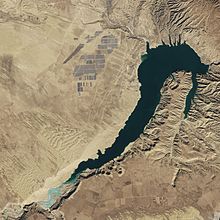

| Part of a series on |
| Renewable energy |
|---|
 |
China is the world's leader in electricity production from renewable energy sources, with over triple the generation of the second-ranking country, the United States. China's renewable energy sector is growing faster than its fossil fuels and nuclear power capacity, and is expected to contribute 43% of global renewable capacity growth.[1] China's total renewable energy capacity exceeded 1,000 GW in 2021, accounting for 43.5 per cent of the country's total power generation capacity, 10.2 percentage points higher than in 2015. The country aims to have 80 per cent of its total energy mix come from non-fossil fuel sources by 2060, and achieve a combined 1,200 GW of solar and wind capacity by 2030.[1] In 2023, it was reported that China was on track to reach 1,371 gigawatts of wind and solar by 2025, five years ahead of target due to new renewables installations breaking records.[2] In 2024, it was reported that China would reach its target by the end of July 2024, six years ahead of target.[3]
Although China currently has the world's largest installed capacity of hydro, solar and wind power, its energy needs are so large that in 2019, renewable sources provided 26% of its electricity generation[4]—compared to 17% in the U.S.[5]—with most of the remainder provided by coal power plants. In early 2020, renewable energy comprised about 40% of China's total installed electric power capacity, and 26% of total power generation. By 2021, it had grown to 29.4% of total power generation. The share of renewables in total power generation is expected to continue increasing to 36% by 2025,[6] in line with China's pledge to achieve carbon neutrality before 2060 and peak emissions before 2030.
China sees renewables as a source of energy security and not just only to reduce carbon emission.[7] China's Action Plan for the Prevention and Control of Air Pollution issued by China's State Council in September 2013, illustrates the government's desire to increase the share of renewables in China's energy mix.[8] Unlike oil, coal and gas, the supplies of which are finite and subject to geopolitical tensions, renewable energy systems can be built and used wherever there is sufficient water, wind, and sun.[9]
China is also a major leader of clean energy technology.[10]: 98 As Chinese renewable manufacturing has grown, the costs of renewable energy technologies have dropped dramatically due to both innovation and economies of scale from market expansion.[9] In 2015, China became the world's largest producer of photovoltaic power, with 43 GW of total installed capacity.[11][12] From 2005 to 2014, production of solar cells in China has expanded 100-fold.[9] However, China is not expected to achieve grid parity – when an alternate source of energy is as cheap or cheaper than power purchased from the grid—until 2022.[13]
The country is the world's largest investor in renewable energy, with the country's companies accounting for four of the world's five biggest renewable energy deals made in 2016.[14] In 2017, investments in renewable energy amounted to US$279.8 billion worldwide, with China accounting for US$126.6 billion or 45% of the global investments.[15] According to researcher Dr Cornelia Tremann, "China has since become the world's largest investor, producer and consumer of renewable energy worldwide, manufacturing state-of-the-art solar panels, wind turbines and hydroelectric energy facilities" as well as becoming the world's largest producer of electric cars and buses.[16]
- ^ a b "China to remain leader in renewable energy capacity growth in 2022". 2 January 2022.
- ^ "China on Track to Blow Past Xi's Clean Power Goal Five Years Early". Bloomberg.com. 28 June 2023. Retrieved 10 July 2023.
- ^ Ahmed, Zo (22 July 2024). "China is on track to meet 2030 renewable energy target six years ahead of schedule". TechSpot. Retrieved 23 July 2024.
- ^ "2019 electricity & other energy statistics (preliminary)". China Energy Portal | 中国能源门户. 21 January 2020. Retrieved 6 January 2021.
- ^ "Electricity in the U.S. - U.S. Energy Information Administration (EIA)". eia.gov. Retrieved 6 January 2021.
- ^ "China could exceed renewables generation target of 33% by 2025". 23 September 2022.
- ^ Deng, Haifeng and Farah, Paolo Davide and Wang, Anna, China's Role and Contribution in the Global Governance of Climate Change: Institutional Adjustments for Carbon Tax Introduction, Collection and Management in China (24 November 2015). Journal of World Energy Law and Business, Oxford University Press, Volume 8, Issue 6, December 2015. Available at SSRN: http://ssrn.com/abstract=2695612
- ^ Andrews-Speed, Philip (November 2014). "China's Energy Policymaking Processes and Their Consequences". The National Bureau of Asian Research Energy Security Report. Retrieved 5 December 2014.
- ^ a b c John A. Mathews & Hao Tan (10 September 2014). "Economics: Manufacture renewables to build energy security". Nature. 513 (7517): 166–168. Bibcode:2014Natur.513..166M. doi:10.1038/513166a. PMID 25209783. S2CID 4459313.
- ^ Cite error: The named reference
:322was invoked but never defined (see the help page). - ^ "China's solar capacity overtakes Germany in 2015, industry data show". Reuters. 21 January 2016.
- ^ "Chinese solar capacity outshone Germany's in 2015". businessgreen.com. 21 January 2016.
- ^ N, Sushma U. "India is beating China in the race to build massive solar power projects". Quartz. Retrieved 22 May 2018.
- ^ Chiu, Dominic (6 October 2017). "The East Is Green: China's Global Leadership in Renewable Energy". Center for Strategic and International Studies. Retrieved 30 July 2022.
- ^ "Global Trends in Renewable Energy Investment 2018 | Capacity4dev". capacity4dev.europa.eu. Retrieved 10 July 2023.
- ^ "Commentary: China will bet big on clean energy to achieve carbon neutrality".